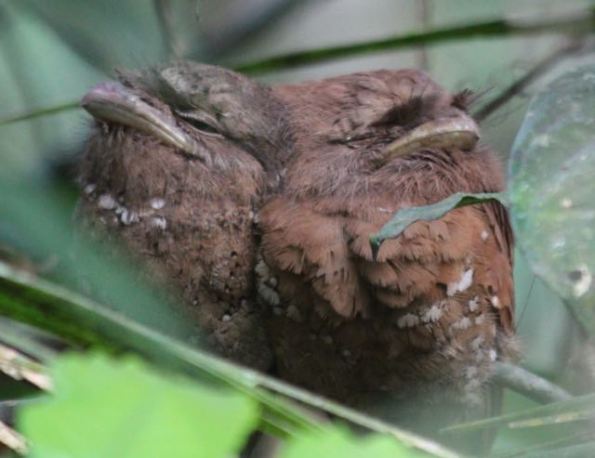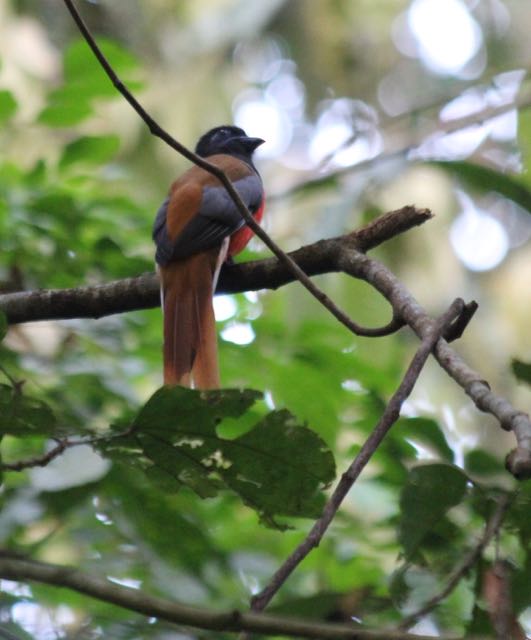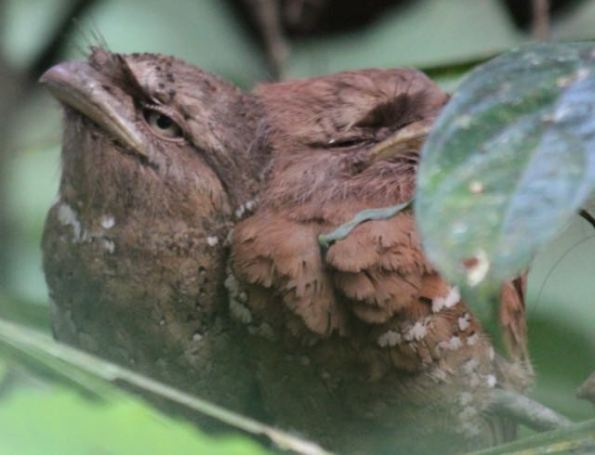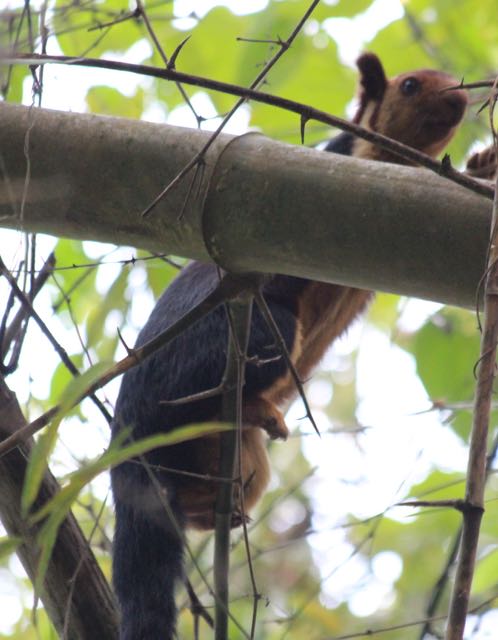Thankful for amazing wildlife sightings

Sri Lanka frogmouths—the female is on the right
Today was Thanksgiving in the United States (wishing everyone a happy one) and we certainly had a lot to be thankful for in terms of our activities, food and wildlife sightings in India.
It began with our second kayaking trip on the Periyar River in Kerala, followed by a splendid breakfast at our lodge, the Soma Birds Lagoon Resort. The rest of the morning gave us time to get caught up on photos and emails (this was one of the best internet connections we’d had in a month, even though it kept dropping out regularly).
Lunch was another feast (and the lodge staff didn’t even know it was Thanksgiving in the US).
But the best was still to come, and it had nothing to do with food.
Anand and Deepti arranged an afternoon bird-watching tour in the Thattekkad Bird Sanctuary. We arrived about 3:30pm and paid the entry fee. Then Deepti inquired about getting a guide.
Yes, yes, a guide is available for 1000 rupees (or $20 across five people). So the guide, Vinod, was booked.

A Malabar trogon shows off his colourful back
As soon as Vinod arrived, we set out on foot and he pointed out various kingfishers and cormorants. Marian wisely interrupted and explained that we’d seen plenty of both species. What we really want to see is the Sir Lanka frogmouth and Malabar trogon, she said.
Vinod eyes brightened and he said We need to go in your van. These species aren’t here. We need to travel to the other side of the sanctuary.
So we hopped in the van and raced (as much as you can race on narrow and bumpy roads) the 8 kilometres to the other side of the sanctuary.
We paid a second admission to the place and set out on foot.
Within 15 minutes, Vinod had led us to a roosting pair of Sri Lanka frogmouths.
Turns out it wasn’t quite as challenging a search as we thought. He’d been in the area earlier in the morning and had spotted the pair (and had also been confronted by a baby and mother elephant at the same time!).
According to Vinod, if these frogmouths are not unduly disturbed (especially by humans) they will nest in the same place/area for months at a time. so he pretty much knew where to look.
The Malabar trogons were a different matter. These birds are not endangered, per se, but they are extremely elusive. They live in dense forests and are hard, if not impossible, to spot.
Vinod wandered along the path and, from time to time, disappeared into the dense scrub. All the while he was mimicking the trogon’s cry or playing it on his phone.
Suddenly he motioned us to follow him. Then with whispering, pointing and waving, he managed to show us one trogon perched high on a limb.
So two magnificent sightings within an hour. What a gift of thanksgiving.

I can see you, but I’ll ignore you—Sri Lanka frogmouths
How clever science is helping frogmouths survive and multiply
According to Vinod, almost 20 years ago, the park rangers in Thattekkad saw frogmouth numbers declining. In the late 1990s, they reckoned only four to six breeding pairs still existed.
Research showed that the women who were collecting wood for cooking were using the bark from a certain branch to tie up their bundles of twigs. These happened to be the branches that frogmouths liked to sit on. This major disturbance affected roosting, mating and more.
So the rangers went to work explaining the situation and handing out strings to women gathering wood. It worked—sort of—but the best solution is that no most people cook with gas (so no need for wood). Frogmouths pairs in the area now number about 80.
A bit more about frogmouths and trogons
The Sri Lanka frogmouth occurs in Sri Lanka (obviously) and the Western Ghats of southern India. They usually live in pairs and grow to about 9 inches in height. They have great camouflage and resemble a bunch of dried leaves, which makes them extremely difficult to spot in the wild.
The Malabar trogons are more widespread in that they occur in Sri Lanka and Western Ghats, as well as parts of central India and the Eastern Ghats. They are brightly coloured, although their front is more colourful than their back (which is all that I managed to photograph). Their populations are declining because of forest fragmentation.

Malabar giant squirrel
Other beasties
We saw quite a few other wild things, including kingfishers, cormorants, Malabar giant squirrels (and one being approached by a macaque monkey), interesting mushrooms, a millipede, a scorpion being consumed by ants and a green imperial pigeon.






WOW… that’s wonderful: stunning photos, amazing wild nature!
Ciao
Sid
LikeLiked by 2 people
Thanks so much. We felt so lucky.
LikeLiked by 1 person
What a great trip. I had never heard of the Malabar Squirrel, nor the Trogon. That scorpion looks best avoided, unless you are with a lot of ants!
Best wishes, Pete.
LikeLiked by 2 people
The ants are definitely taking care of the scorpion. His days are over.
LikeLike
What a fabulous expedition. I would ave loved doing that! I imagine that scorpion’s very confused 🙂
Alison
LikeLiked by 2 people
Sadly, or happily, that scorpion was very dead and being chomped to bits by ants.
LikeLiked by 1 person
👍 That’s seems to be a pleasurable trip around India and the sightings.
Good going !
All the best for the rest of the days.
Shiva
LikeLiked by 1 person
Thanks so much. We are having a wonderful time.
LikeLiked by 1 person
Thank you so much for your postings! Such wonderful adventures and you are so kind to share with us.
LikeLiked by 2 people
I’m so glad I am able to share. Works like a diary for me, and I’m pleased when other people enjoy it too.
LikeLike
Wow, that $20 for your guide saved a lot of hunting. You certainly picked the right one who knew where everything was. Loved how they found out why the frogmouths were not thriving and fixed the situation. It would be wonderful if that could be done with other endangered species. Like the orangutan , just stop destroying their habitat. Thank you for another very interesting post Peggy.
dorothysstories.wordpress.com
>
LikeLiked by 1 person
That was $20 so very well spent, and it was really only $4 per person across the five of us. I loved the frogmouth solution, too. If only it was so easy to rectify the situation for other species.
LikeLike
A trip of a lifetime! Enjoy!
LikeLiked by 1 person
Thanks. We are.
LikeLiked by 1 person
Sounds like a wonderful array of wildlife. I’m sure I would have a ‘field day’ trying to spot them in the trees (and then the challenge of photographing them).
Good to hear the Frogmouths have survived and thrived. There’s too many birds, animals & insects faced with extinction in modern times.
LikeLiked by 1 person
India has a remarkable array of wildlife, and we have been fortunate to see so many species. My heart breaks to think about creatures becoming extinct. So not right.
LikeLiked by 1 person
The scorpion is more than confused, I reckon he is being infused. Beautiful frogmouths. Glad they are increasing in numbers. The more the merrier.
LikeLiked by 1 person
Oh yeah, the ants are taking care of that scorpion. And the forest is taking care of the frogmouths.
LikeLike
Those frogmouths look like little cartoon characters! Happy thanksgiving Peggy!
LikeLiked by 1 person
Oh wow, you’re right. They do! Happy Thanksgiving to you too.
LikeLiked by 1 person
Nice blog, lovely pics, following!
LikeLiked by 1 person
Thanks so much. I look forward to checking out your blog when I’m back in Australia and have a half decent internet connection. 🙂
LikeLiked by 1 person
You just have to love the Frogmouths, Peggy. They look like cartoon characters. Thanks for sharing. –Curt
LikeLiked by 2 people
You are right. The frogmouths look exactly like cartoon characters, especially the female.
LikeLiked by 2 people
Amazingly big squirrel!
LikeLiked by 1 person
They are really big for squirrels and their tails are especially long.
LikeLike
Very nice your pictures for animals
LikeLiked by 1 person
Thanks so much.
LikeLike
Seriously kerala is extremely beautiful. Sad, I still didn’t see it… 😞😔
LikeLiked by 1 person
Kerala is wonderfully beautiful. I hope you get a chance to see it.
LikeLiked by 1 person
I want to go to munnar and aleppi, both very nice. And definitely experience the houseboat.
LikeLiked by 1 person
I can highly recommend both Munnar and Aleppi. The houseboats are fantastic.
LikeLike
Nice photos Peggy. The frogmouths look so content.
LikeLiked by 1 person
That’s a perfect description—so content!
LikeLiked by 1 person
Thank you for sharing all this beauty, Peggy 🙂
LikeLiked by 1 person
My pleasure. We have been travelling very remotely, so it’s nice when I can post. 🙂
LikeLiked by 1 person
Love this! I always love to see wildlife and I have never heard of some of these creatures. Great pics!
LikeLiked by 1 person
Thanks. India is filled with wonderful creatures.
LikeLiked by 1 person
I am always rollercoaster about the whole exploration thing. You have my admiration on your adventures!!
LikeLike
Trust me, if you ever want to travel widely in India, I can highly recommend Overland Expeditions India with Anand and Deepti. We’ve done three trips with them in three years.
LikeLike
A wonderful place to visit, Peggy, and such beautiful wildlife. You also did well to find that guide who knew just where to look for the frogmoths. I have to say, the pics of Sri Lanka frogmouths made me laugh and I can see how the bird got its name. The Malabar trogon is very pretty, and I think he knows it, too. A real poser, that one. A fabulous trip, especially at that price.
LikeLiked by 1 person
The frogmouths are so cute and really quite small. Only about 6–7 inches tall. The trogon is a beauty but I think if he was really a poser, he’d have shown us his front which is even flashier.
LikeLike
Nature beats historical sites any day. No offense to history buffs! Thanks for sharing! The birds look like Siamese twins. 😛
LikeLiked by 1 person
Yes, I’m partial to wildlife too. Felt so lucky to see the birds together.
LikeLiked by 1 person
Thanks for following! Hope you like what you read. 🙂
LikeLiked by 1 person
I’m sure I will.
LikeLike
Woah – some beautiful photos! Great blog ❤
xxx
https://colourpotblog.wordpress.com/
LikeLiked by 1 person
Thanks for stopping by and for commenting.
LikeLiked by 1 person